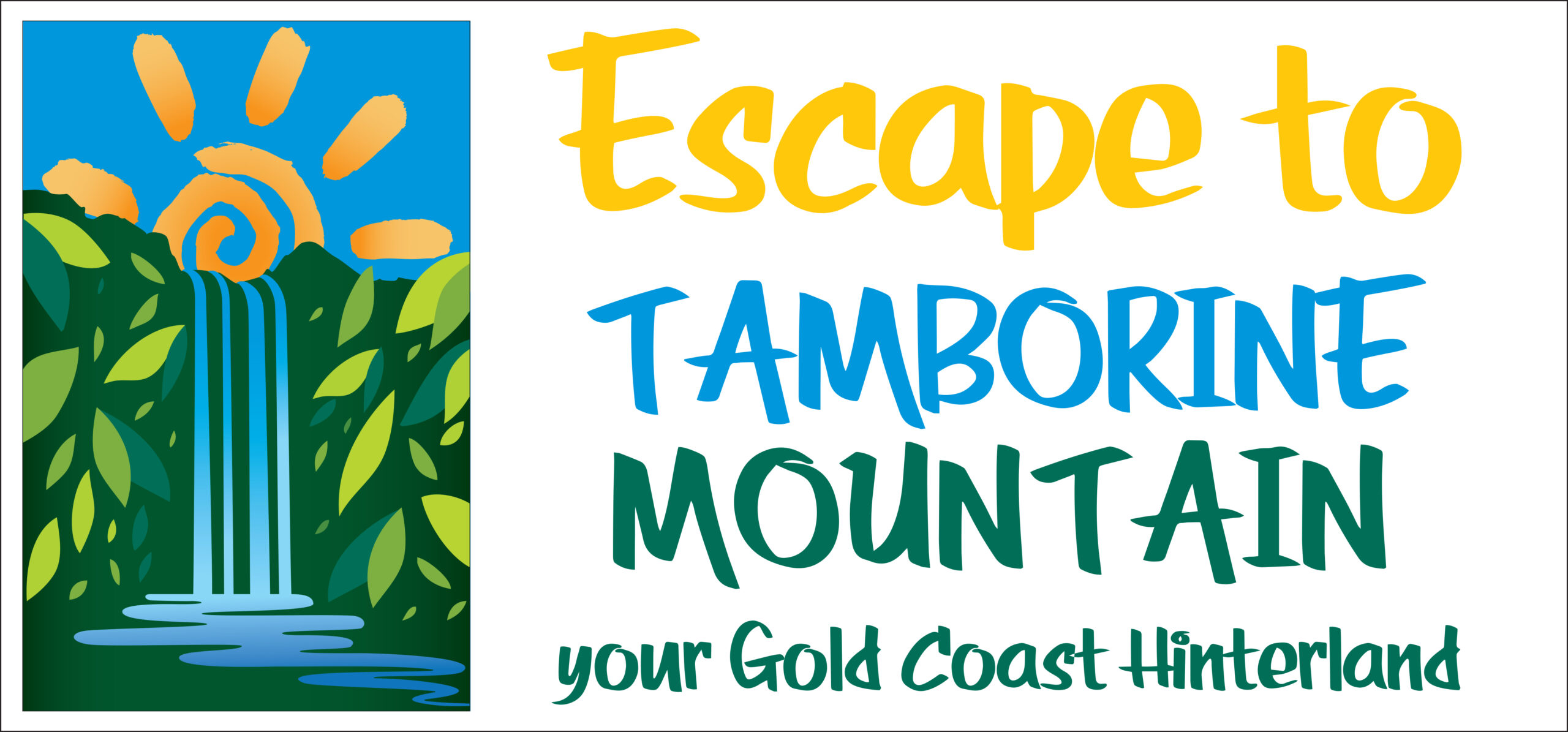THE MT TAMBORINE STORY – THE GREEN BEHIND THE GOLD
Tamborine Mountain is a beautiful lush green mountain plateau in the Gold Coast Hinterland, only an hour’s drive from Brisbane or Surfers Paradise. It is home to the first-ever National Park in Queensland and a secret hideaway for Australia’s city dwellers.
It is hard to put in words the beauty and tranquility of the Tamborine Mountain plateau (also often referred to as Tamborine Mountain, Mount Tamborine, Mt Tamborine, or Tamborine Mtn), located only 30kms from the Gold Coast and 70kms from Brisbane.

At every turn, you will encounter breathtaking scenery and views, abundant wildlife, and clean mountain air. Also, a strong cottage industry including many local arts and crafts, a host of natural and man-made attractions, award-winning wineries and top-class restaurants, country markets, festivals and events, a whole host of accommodation choices including romantic couples’ cottages and B&Bs await you on Tamborine Mountain.
Pick up your personal copy of the Tamborine Mountain Map Guide from one of over 1,800 outlets located between Ballina and the Sunshine Coast – you will find lots of them concentrated on the Gold Coast and Brisbane – and of course all over the mountain!
Tamborine Mountain
Tamborine Mountain is part of the famous Gold Coast Hinterland, south of Brisbane, in South East Queensland, Australia. The plateau is about 560m high and measures 18 km long and 14 km wide. It has 3 small villages (North Tamborine, Eagle Heights, and Mount Tamborine) with a total population of just under 7000.
The plateau originated from the Mount Warning volcanic eruption 22 million years ago and is part of the Scenic Rim Regional Shire. The plateau looks down on the surrounding lowlands, to the Gold Coast and the Pacific Ocean to the east, and all the way to the Great Dividing Range to the west. The Gold Coast view is breathtaking by day, but by night the panorama of lights is even more stunning.
Tamborine Mountain was the home of the Wangerriburra aborigines tens of thousands of years before white settlement. It was completely covered by subtropical rainforest, which was cleared at a rapid pace for agriculture and timber production after it was opened for selection in 1875. Fortunately in 1908 efforts were made to protect the natural beauty of the mountain and the very first National Park was created in Queensland – Witches Falls National Park. Over the years 12 separate sections with mainly remnant rainforest were added to the original National Park, almost encircling the plateau, and named ‘Tamborine National Park’. Most areas have well-defined and easy to negotiate bushwalking tracks right through the rainforest.

Tamborine Mountain Climate
Queensland is known as the Sunshine State of Australia. On Tamborine Mountain, you can enjoy abundant sunshine with less heat and humidity that more northerly parts of Queensland sometimes have to endure. The climate is subtropical, with an annual rainfall of about 1600 mm falling mainly between December and March. Temperatures vary between max 18°C in winter and 28°C in summer, averaging some four or five degrees cooler than the surrounding lowlands. Because of this relatively large temperature difference in close proximity to the city, Tamborine Mountain proves to be a popular destination for city-dwellers, coming up the mountain in winter to celebrate Christmas in July in front of a log fire.
Tamborine Mountain has the traditional four seasons, but no real extremes in temperature. Most areas are frost-free during most winter seasons. Winter days usually dawn to clear blue skies, but the evening brings a distinctive chill to the air, with fog and clouds on wet nights.
The first part of summer is marked by warm clear days and spectacular evening thunderstorms in the traditional tropical style. Sometime after Christmas, the summer rains carried in from further north by the North-West Monsoon reach down to replenish the underground water supply that provides garden and irrigation water for most of the area. Although the humidity can be relatively high during this latter part of summer, the temperatures are quite mild and you only realize how high the humidity must be when you see the mountain mists.
With its cool climate and spectacular scenery, as well as its proximity to Brisbane and the Gold Coast, Tamborine Mountain has become a very popular getaway destination for the locals.

Tamborine’s Fauna
Tamborine Mountain has a healthy snake population and the local snake catchers are kept busy relocating mainly totally harmless snakes such as the carpet python back into the bush. One reason for the snakes’ success is the relatively low cane toad population. Because of the high altitude and correspondent cooler winters, cane toads are unable to build up large populations, so lethal toxic ingestion of cane toads is reduced on the mountain plateau.
Tamborine Mountain is also home to the giant earthworm, which grows up to 1 meter long and comes up to the surface after very heavy rain.
The mountain is a sanctuary for the native flora and fauna. Birdwatchers especially appreciate the variety of some very rare bird species on the mountain. Lyrebirds, scrub turkeys, brilliant parrots and lorikeets, tawny frogmouth, whip birds, and inquisitive bowerbirds populate the rainforests and can often be seen and always heard. Bird feeding is enjoyed by locals and tourists alike.
Elusive platypuses live in the clear mountain creeks and at night the glowworms glow in the rainforest.

If you can find the time to walk through some of the National Parks you will hear many other bird songs and see an amazing range of Australia’s birdlife. The Brush Turkey inhabits both rainforests and home gardens. The male builds huge mounds of leaf mulch, and then the female lays her eggs in the mound and walks away leaving him to manage the entire incubation process.
There are quite a few cute furred creatures like ringtail and brush-tail possums, bandicoots, koalas, and wallabies as well.
For some extra colour watch the myriad of butterflies throughout the Mountain and a wide variety of frogs, especially the green tree frog, welcome the summer rains with a cacophony of sound.
5 Reasons to Escape
to Tamborine Mountain
Where else can you explore nature, enjoy local
wines, gins & beers, eat great food, have fun,
sit amongst the lorikeets & watch the sunset, look at unforgettable
night skies – .all in one day.
Mt Tamborine’s Flora
With its fertile red volcanic soil and high rainfall, the plateau produces rich crops of avocados, kiwi, macadamia nuts, and rhubarb. Private gardens, as well as the TM Botanical Garden, thrive and produce colorful displays any time of the year.
The original vegetation was predominantly sub-tropical rainforest. Valuable cabinet timbers such as the Australian Red Cedar lured the first settlers to Tamborine Mountain over 100 years ago. Since then much of this dense forest has been cleared to make way for farming, although many remnant stands of the original forest still exist. The most amazing of these are the belts of Piccabeen Palm forest around creeks and waterfalls.
And for a bit of “Funny Trivia”….
Tamborine Mountain” (also often referred to as “Mount Tambourine”) is a volcanic rim plateau which has three townships or suburbs – “Eagle Heights”, “North Tamborine” and “Mount Tamborine”. A small township called “Tamborine” or “Tamborine Village” is actually not part of Tamborine Mountain as such, as it is off the actual mountain, and is 50 meters above sea level at the foothills of Tamborine Mountain itself.
The highest point, the “peak” of the Tamborine Mountain plateau is 578.2 meters above sea level, and you can drive your car right onto it! It is located in North Tamborine, on the bend where Shiloh Drive turns right and becomes Sequoia Drive, the actual peak is the center of the large circular flat bitumen street corner.
The peak itself is also called “Tamborine Mountain”, or “Wonglepong” as the Aborigines would refer to it.
So North Tamborine is located south of Tamborine, Eagle Heights is not the high(t)est point of Tamborine Mountain, and Mount Tamborine is part of Tamborine Mountain but not Mt Tamborine itself – glad we got that right!?


